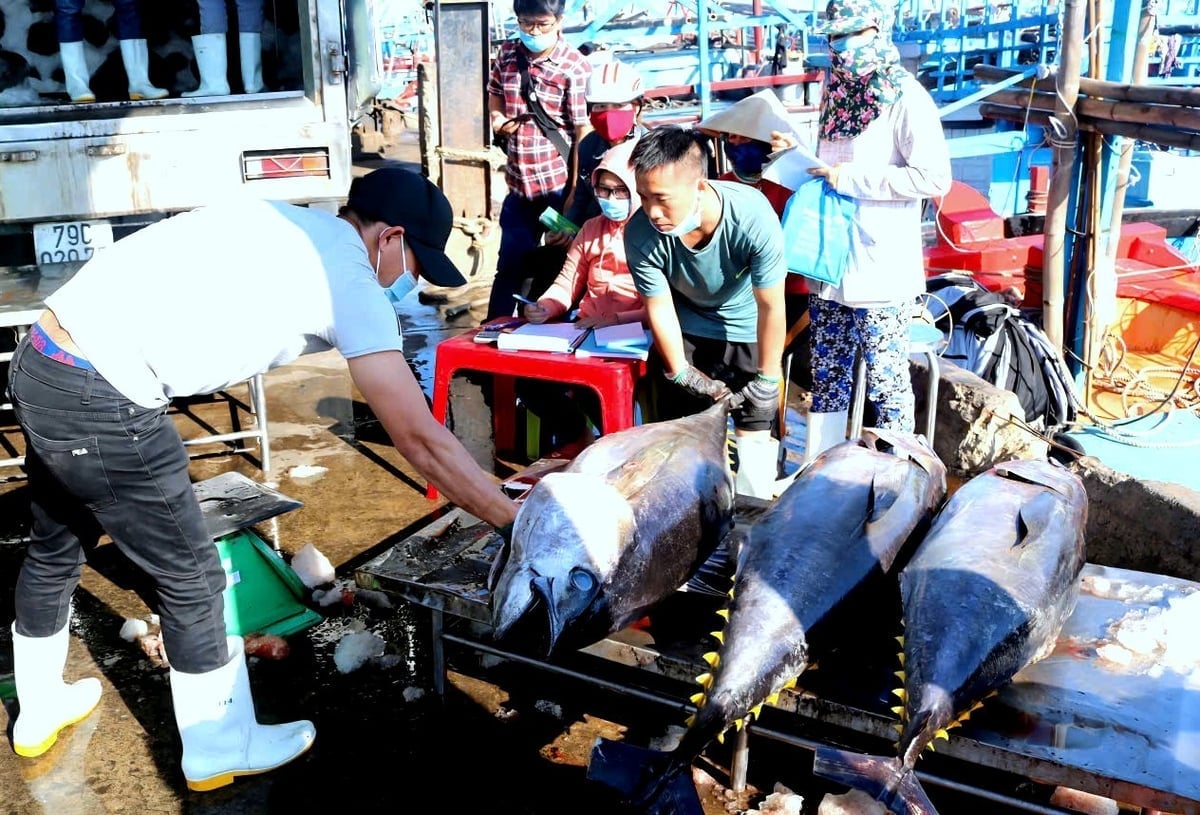November 27, 2025 | 05:22 GMT +7
November 27, 2025 | 05:22 GMT +7
Hotline: 0913.378.918
November 27, 2025 | 05:22 GMT +7
Hotline: 0913.378.918

Tuna is inspected for quality by enterprises before being delivered to processing plants. Photo: Kim So.
According to the Vietnam Association of Seafood Exporters and Producers (VASEP), in the first six months of 2025, the country’s total tuna export turnover reached nearly USD 473 million, up slightly by 0.2% compared to the same period last year. In June 2025 alone, tuna exports recorded a significant decline.
This indicates that in the second half of 2025, the industry will face many difficulties, making it hard for tuna exports to achieve the same goals as in 2024. The main causes of this decline are attributed to domestic raw material shortages and strict traceability policy barriers.
According to Vu Dinh Dap, Chairman of the Vietnam Tuna Association, the most urgent issue at present lies in problems arising from Decree 37/2024/ND-CP. Specifically, the regulation requiring skipjack tuna caught to reach a minimum size of 500 mm (50 cm) has been causing major obstacles for fishermen and processing enterprises.
The common size of skipjack tuna caught in Vietnam ranges from 150–400 mm (15–40 cm). The proportion of tuna meeting the standard above 500 mm accounts for only a very small part, about 5–8% of total catches.
Several enterprises confirmed this figure, stating that skipjack tuna with a length of 20–25 cm accounts for up to 90–95% of total catches, while only about 10–15% are above 50 cm, according to statistics from the Binh Dinh Fisheries Sub-Department.
This situation has led to an inevitable consequence, which is a severe shortage of raw materials for enterprises. A survey by the Association showed that purchased raw materials decreased sharply by 66–87%, with some enterprises reporting that the proportion of raw materials meeting the requirements of Decree 37 was 0%. This prevents companies from securing sufficient raw materials for production and processing, directly affecting the livelihoods of thousands of fishermen.

Tuna processing plant for export. Photo: Kim So.
Alongside domestic policy challenges, Vietnam’s
tuna industry also faces pressure from major export markets. In the EU market, export orders have dropped sharply by 32–87.5% and export value fell by 35.4–80.7%, mainly because of the inability to meet source-of-catch certification requirements (SC/C/C).
Canned tuna export turnover to the EU continuously declined in the last months of 2024. The proportion of Vietnamese-origin tuna eligible for tariff preferences under the EVFTA quota also dropped sharply from 80–100% to only about 30% in the last two years, mainly because enterprises could not provide sufficient documentation proving origin.
In addition to the EU, the US market also poses risks since the US is one of the four largest importers of Vietnam’s tuna. Higher import tariffs will increase the price of Vietnamese tuna products, reducing competitiveness compared to other suppliers.
In response to these challenges, the Vietnam Tuna Association has made several recommendations and proposed solutions. First and foremost is the urgent amendment of Decree 37/2024/ND-CP and Decree 38/2024/ND-CP through a shortened procedure. The amendments should be flexible and differentiate skipjack tuna caught for canned processing. At the same time, the Association also proposed shifting from size-based management to quota-based management to align with international practices and the regulations of regional fisheries organizations.
In addition, the Association emphasized the necessity of simplifying administrative procedures and digitizing processes, especially in traceability, verification, and certification of seafood of exploited origin (SC/C/C).

Vietnam Tuna Association proposes urgent amendment to Decree 37/2024/ND-CP. Photo: Kim So.
The Association also recommended improving the legal and fisheries management system to meet the requirements of the European Commission, thereby contributing to lifting the IUU "yellow card." Regulations such as "not mixing imported exploited seafood raw materials with domestically exploited seafood raw materials in the same export shipment" also need to be reconsidered as they create difficulties for enterprises.
For a long-term strategy, the Chairman of the Vietnam Tuna Association suggested focusing on market diversification. While maintaining and consolidating traditional markets such as the US, the EU, the Middle East, and CPTPP countries (11 members), enterprises should explore opportunities in emerging markets such as South Korea, Egypt, Lebanon, Lithuania, Romania, and Libya. These markets are showing positive signals due to rising demand for convenient and affordable food.
The global market in 2025 will be a pivotal year for structural changes, where competition will be based on quality, sustainability, and clear traceability rather than merely low prices.
According to Vu Dinh Dap, if institutional obstacles are not promptly resolved, especially through substantial, flexible, and scientific amendments to Decree 37, Vietnam’s tuna industry may miss opportunities and lose its advantages to regional competitors such as Thailand, Indonesia, and Ecuador. IUU fishing remains a global hotspot, exerting significant pressure on exporting countries. Transparent supply chains have become a standard.
Translated by Huong Giang

(VAN) China’s cooking oil is suddenly flooding into India. It all comes down to a soybean surplus that Beijing doesn’t quite know what to do with.

(VAN) An Giang promotes supply-demand connections, standardizes quality and builds value chains, creating a foundation for sustainable bird’s nest development and aiming to expand exports.
/2025/11/24/5339-4-nongnghiep-075331.jpg)
(VAN) Recently, the conference on 'Sustainable Fisheries Linkage Chain - Tilapia for Export' took place in Tien Hai commune, Hung Yen province.
/2025/11/21/4309-2-153400_128.jpg)
(VAN) Green and low-emission rice is paving the way for Vietnamese rice to enter high-end markets, marking the beginning of a transformation journey toward greening and elevating the national rice brand.

(VAN) ‘Right to Win’ outlines a national action plan that shapes a new vision for Viet Nam’s agriculture in an era of renewal and global integration.

(VAN) Lam Dong’s farmed sturgeon output this year is expected to reach 2,300 tons, worth VND 450 billion, affirming the brand’s position on the market.

(VAN) A surge in Ukrainian egg exports, largely driven by soaring sales to the UK over the last few years, has notably pushed up egg prices on the domestic market.